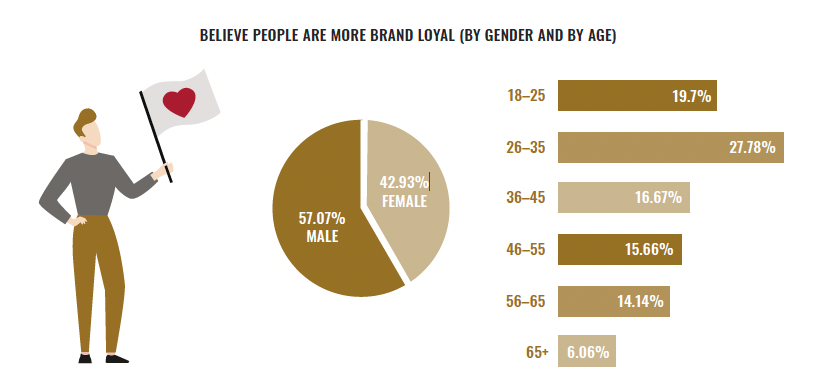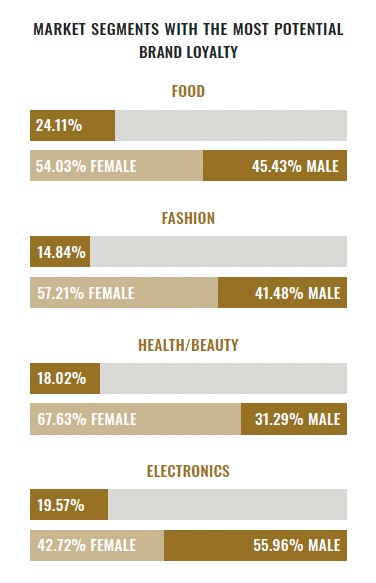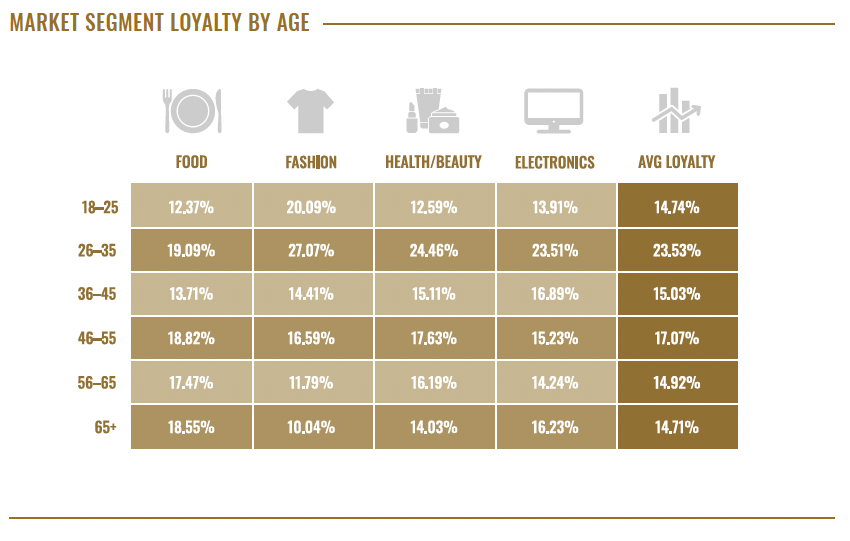August 18, 2022
ASL May Be BS for Brand Loyalty ROI
David Brashears

How traditional demographics aren’t panning out for brand targeting
Creative Energy has spent 30 years building an agency on the idea that people want to support companies that bring them joy and comfort. Brand loyalty is the product of human connections. The more our clients invest in being open, genuine, and kind in their brand messaging, the more we see their investment return engaged and profitable dividends.
Some would say that brand loyalty is generational, but when we evaluated our own survey data for our Cult Brand Case Study, we found that brand loyalty behavior is not tied to any specific age, gender, or region. Below is an infographic that explains the breakdown of respondents.

We saw from our findings there is very little difference in perspective between the men and women that answered on which direction brand loyalty is currently moving. It’s nearly a perfect split between the two, and both agree on consumers want to believe in the brands they support. Age, on the other hand, does seem to impact buyer behavior. It doesn’t, however, show a clear target of one generation that should be focused on in order to garner brand loyalty. That requires a much more complete picture of a brand’s specific brand position and promise in order to properly develop a targeted plan. As you can see from the responses we received, all generations are well-represented up to age 65 and above. There is, of course, a swell of brand loyalty value in the key consumer age group (shoppers between the ages of 26 and 35).
It’s important to recognize that if you target strategic messaging and tactics on a very niche message that engages this one age group, it has the potential to alienate or be irrelevant to your other potential customers. In many cases, it may be easy to see that this age group is the easiest to influence, but remember that they still only represent 28% of the market overall.
DEMOGRAPHIC MARKETING CAN LEAVE BRANDS AND THEIR AGENCIES BLIND TO BIGGER-PICTURE THINKING. INSIGHTS OUTSIDE OF DEMOGRAPHICS ALONE SHOULD BE CONSIDERED BECAUSE THEY COULD UNCOVER AN ENTIRELY NEW POTENTIAL CUSTOMER GROUP.
We also asked participants to tell us what market segments they have the most brand loyalty within. While there were many markets that were represented, there were four that clearly had the greatest potential to impact buying behaviors with sound brand practices. Here is a graphic of what we found.

The common theme of all four of these segments that enjoy higher brand loyalty is their relationship with a consumer’s identity. These are all segments that provide products and services that consumers relate closely with their own quality of life and personal worldview. It’s not surprising, then, that consumers would spend more time researching and discussing brands within these categories in a much more invested manner. You can also see that only one of these segments has any real imbalance in their consumer base as it pertains to gender.
Health and beauty, which has historically focused the majority of its messaging toward women, is seeing two-thirds of its audience reached. That leaves a third of their potential audience either neglected or completely alienated from their brand position. Having a deeper understanding of how modern shoppers behave can help improve brand loyalty by inviting a greater number of consumers to engage with products and services. The difference in beliefs about these segments by generation is also interesting. We broke down responses by age and found even more support for our perspective on brand value.

As we noted in our research, brand loyalty is well represented by every generational segment we surveyed. Shoppers in the 26–35 age range seem to be doing the heavy-lifting in supporting brands they believe in, but they are far from a majority if we look at these top four market segments. The averages for these segments show that 46–55 is actually the second most engaged generation when it comes to developing brand loyalty—rather than the 36–45 as might be expected. While there are many factors that can influence this discrepancy, it’s likely due to changes in a person’s season of life. Many people in the 36–45 age range may be changing jobs, starting their family, purchasing homes, or going back to school for an advanced degree—or a combination of several of these life events. These factors can mean they are dealing with a more strict budget and may not have as much discretionary income to put towards supporting their favorite brands. It’s also important to consider the relationship your brand has with those over 65+. While they are, on average, the smallest represented group according to our survey, they are only slightly less engaged than the highly coveted 18–25 age group. So, why are they so often disregarded when it comes time to build a brand strategy?
There are several factors, but most of them are related to the complication that this group represents a perspective that trends towards values and convictions that may be waning in relevance. This disparity may be further compounded if your brand position and promise are in any way politicized or founded on social trends that may not relate to an older audience. However, building a solid marketing strategy that is relatable and attainable by a wider audience by focusing on more human personality traits, and fewer hot button topics, can produce a bigger and more diverse group of brand loyalists that influence a much more dynamic community of brand prospects.
The fact of the matter is that the potential to garner brand loyalty has not diminished at all, and in many ways is higher than it has ever been. With the proliferation of social media, access to corporate information online is higher than it has ever been, and consumers that are more passionate about tying their economic support to their own social worldview, companies, and brands can have a huge impact on their loyal brand supporters through a unified and consistent brand messaging strategy that resonates with the greatest number of consumers with like-minded perspectives. Building brand loyalty is more valuable than in any past economic era, and the benefits of investing in a solid strategy can be historic.
As noted at the beginning of this article, Creative Energy takes great care in our targeting strategies to ensure our client’s advertising and marketing efforts are built on human experience—not on arbitrary data trends. We work to develop a brand belief system that is accessible and relevant to their audience. This is how we create sustainable cult brand loyalists that identify at a core level with the brands we represent. If you’re ready to rethink your targeting strategies, then reach out to us. Our team is excited to help you build your community!
Get insights delivered straight to your inbox.